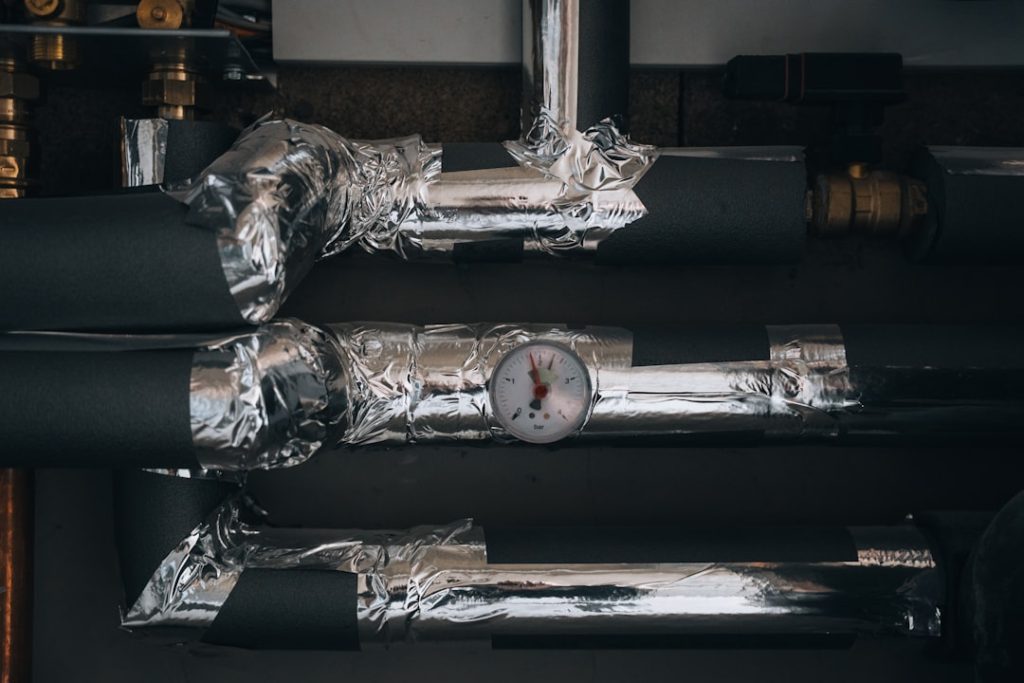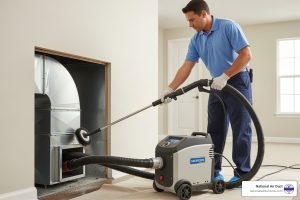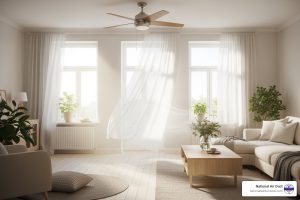Your Home’s Lungs and the Air You Breathe
When you disinfect HVAC system components, you’re essentially giving your home’s respiratory system a deep clean. Here’s what you need to know:
Key Methods to Disinfect HVAC Systems:
- Professional source removal cleaning – Physical removal of contaminants using high-powered vacuums
- EPA-registered chemical sanitizers – Applied after cleaning to reduce bacteria by 99.9%
- UV-C light technology – Continuous, chemical-free sanitization that disrupts microbial DNA
- Combination approach – Source removal plus UV lights for ongoing protection
Your heating and cooling system is literally the lungs of your home. Just like NADCA states: “if your air ducts look dirty, they probably are.” And here’s the reality – contaminants get pulled into your HVAC system and re-circulated 5 to 7 times per day.
Think about it. Every breath you take has passed through your home’s ductwork, coils, and filters. When these components harbor dust, mold, bacteria, or other contaminants, your family breathes it all in.
Indoor air pollutants are often 2 to 5 times higher than outdoor levels – and sometimes exceed outdoor pollution by 100 times. That’s why proper HVAC cleaning and sanitization isn’t just about comfort – it’s about your family’s health.
But here’s what most homeowners don’t know: there’s a big difference between cleaning, sanitizing, and disinfecting. The EPA has strict rules about what products can be used where. And despite what some companies claim, HVAC contractors legally cannot claim to ‘disinfect’ ductwork in the United States.
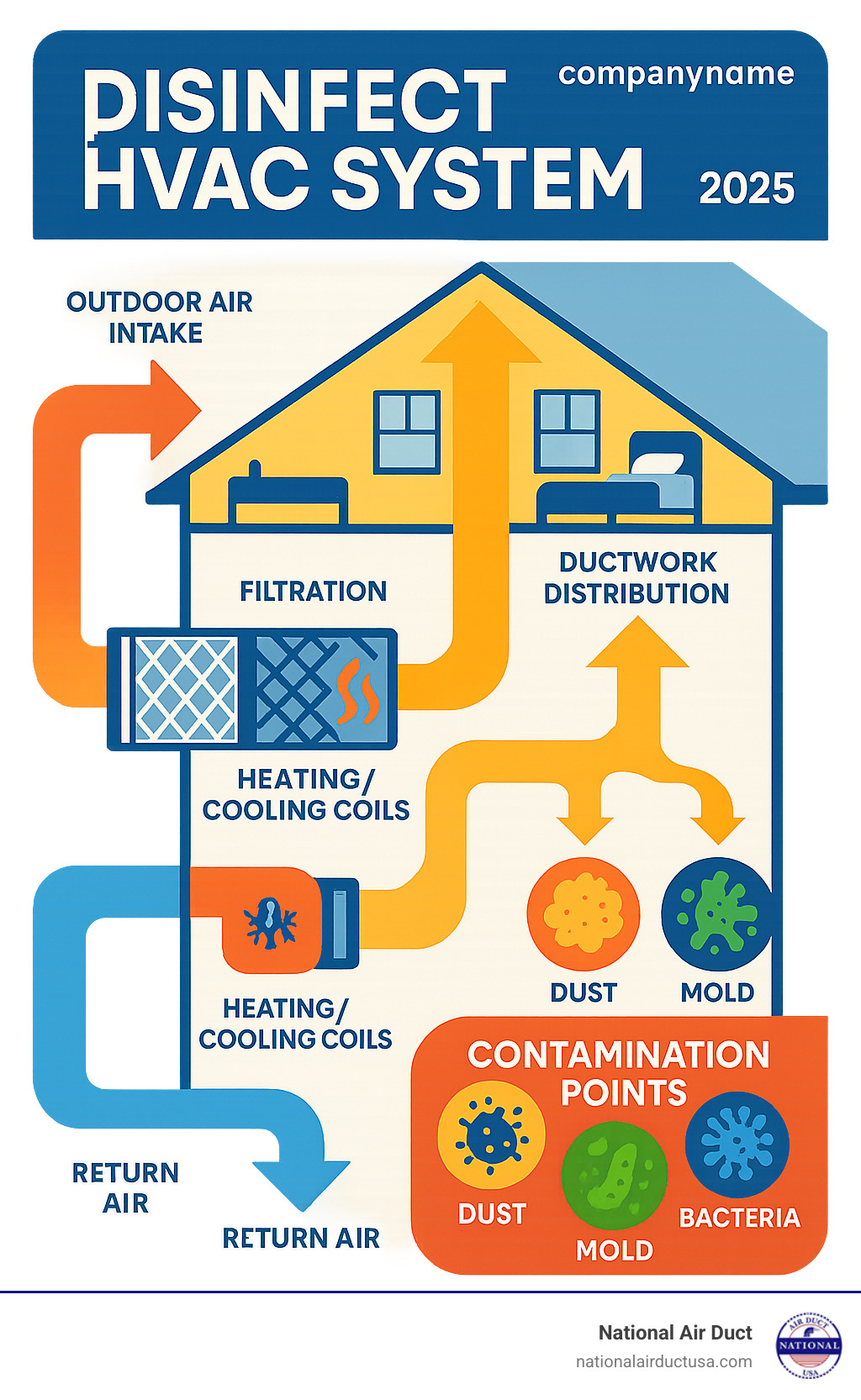
Cleaning vs. Sanitizing vs. Disinfecting: What’s the Difference?
When people want to disinfect HVAC system components, they’re often referring to three distinct processes: cleaning, sanitizing, and disinfecting. The terms are frequently confused, but the distinction is critical. The EPA has strict definitions for each term, and using the wrong approach can be ineffective or even illegal. NADCA standards emphasize that correct terminology ensures the job is done right.
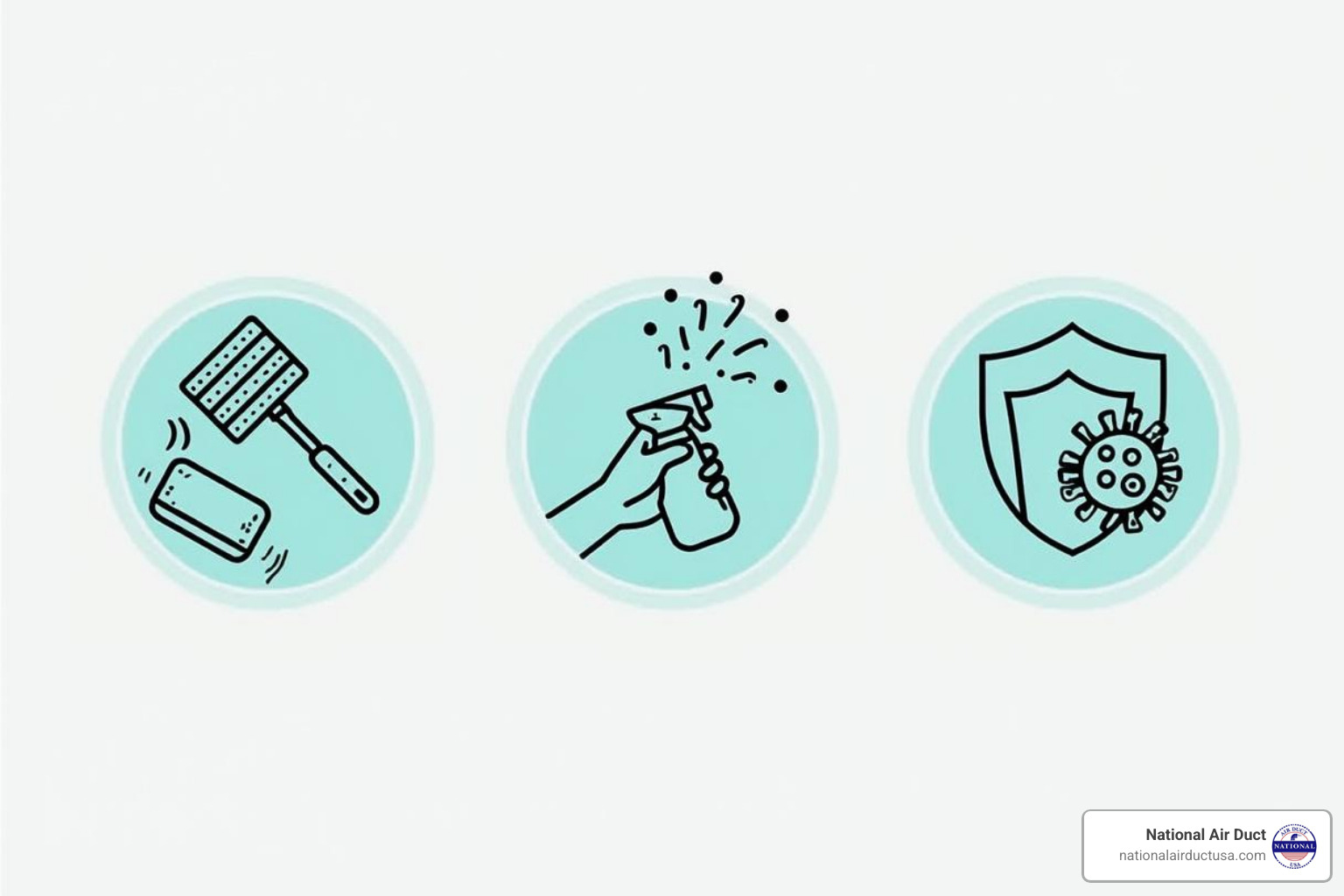
Simply put: cleaning removes debris, sanitizing reduces bacteria, and disinfecting eliminates specific pathogens. The guiding principle is always source removal first—you can’t effectively treat what you haven’t properly cleaned.
Cleaning: The First and Most Crucial Step
Cleaning is the physical removal of debris—all the dust, dander, and pollen built up in your system. It’s about getting the gunk out, not just treating it. This debris restricts airflow and creates a breeding ground for microorganisms.
NADCA teaches that source removal is the single most effective method. This means physically breaking contaminants loose and collecting them with powerful vacuums.
The blower is your system’s heart; learn why keeping it clean is vital in our guide on blower cleaning.
Cleaning is the prerequisite for everything else. You wouldn’t sanitize a dirty dish, and the same logic applies to your HVAC system.
Sanitizing: Reducing Bacteria
Once a system is clean, sanitizing becomes an option. A sanitizer is an EPA-registered product that reduces bacteria by 99.9% on treated surfaces. Note the key word is reduces, not eliminates.
Sanitizers are designed for bacteria and won’t affect mold unless the label specifically says so, as mold is a fungus. Sanitizing is considered for specific contamination issues or when extra microbial control is needed, but it only works on a properly cleaned surface.
Disinfecting: The Highest Level of Kill Claim
Disinfecting eliminates viruses and fungi, making it the highest level of microbial kill claim. However, the EPA has not registered any products for “disinfecting” ductwork specifically. This means any company claiming to disinfect your air ducts is making misleading claims that violate federal law.
The Federal Insecticide, Fungicide and Rodenticide Act (FIFRA) makes it illegal to use products in ways not specified on their labels. Reputable, NADCA-certified professionals focus on thorough cleaning followed by appropriate sanitization of specific components when needed, always adhering to EPA guidelines.
Why a Comprehensive HVAC Cleaning is Non-Negotiable
Your HVAC system pulls air through your home 5 to 7 times daily. If it’s dirty, you’re breathing in whatever is lurking inside. A comprehensive cleaning is essential for your family’s health and wallet.
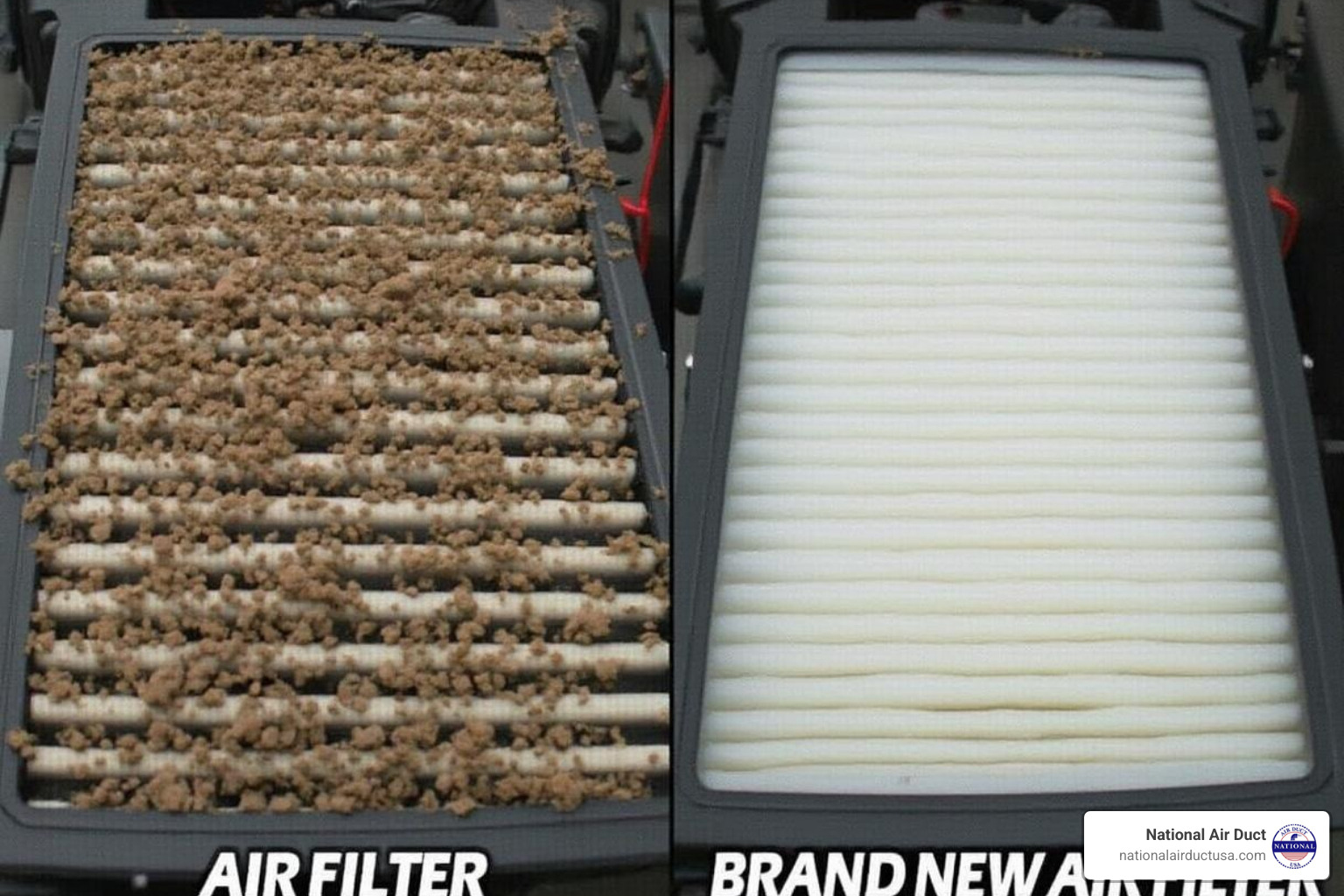
According to the EPA, indoor air can be 2 to 5 times more polluted than outdoor air. Properly cleaning HVAC system components improves air quality by removing dust, dander, mold spores, and bacteria.
It also impacts your budget. The U.S. Department of Energy found that 25 to 40 percent of heating and cooling energy gets wasted by dirty systems. A thorough cleaning can cut your energy bills by 20 to 30 percent. Plus, a clean system lasts longer, helping you avoid costly repairs or premature replacement.
Key HVAC Components That Need Cleaning
A comprehensive cleaning means addressing the entire system, not just the ducts. A partial cleaning is ineffective. Here’s what needs attention:
Your air ducts are just the start. The evaporator and condenser coils collect debris and moisture, making them critical to clean. Learn more in our guide to Coil Cleaning. A neglected drain pan can become a swamp, and a dirty blower motor and housing dramatically reduces airflow. Our guide to Blower Cleaning explains its importance. Finally, the registers and grilles, air plenum, and heat exchanger (in furnaces) all play a role and require cleaning.
The Risks of a Dirty System
A dirty HVAC system poses several risks. Respiratory conditions and allergies can worsen from breathing contaminated air. Dirty components cause system efficiency to plummet, leading directly to higher energy bills. The potential for mold growth is also a major concern. Moisture and dirt create ideal conditions for mold, which can spread spores throughout your home, leading to health issues and costly repairs. Learn what can happen when prevention is ignored in our guide to HVAC Repair.
A comprehensive HVAC cleaning is an investment in your family’s health, comfort, and finances.
How to Properly Disinfect an HVAC System: Methods and Technologies
To disinfect HVAC system components effectively, you need proven professional methods, not quick fixes. The best approach combines several techniques. Just as you wouldn’t just use air freshener to clean your house, a proper HVAC treatment involves professional source removal methods, EPA-registered chemical treatments, and UV light technology to ensure the healthiest air for your family.
Method 1: Professional Source Removal Cleaning
NADCA recommends source removal cleaning as the gold standard. This method physically breaks loose and removes all dirt and debris from your system. We use specialized agitation tools (brushes, air whips, compressed air nozzles) that blast dirt with 250 PSI of pressure. Simultaneously, the entire system is put under negative pressure with industrial-strength vacuums.
Equipment matters. While some companies use portable vacuums (~5,000 CFM), we use truck-mounted vacuum systems that deliver 12,000 CFMs of suction for superior results. This powerful suction ensures all contaminants are contained. We create and seal access points as needed to reach every corner. Learn more about our Residential Air Duct Cleaning process.
Method 2: Applying EPA-Registered Chemical Sanitizers
After a thorough cleaning, we may recommend chemical sanitizers for specific issues like bacterial growth or persistent odors. This is a secondary step, not a standalone solution. We use a fogging method to apply a fine mist, aiming to reduce bacteria by 99.9% on cleaned surfaces.
We favor Thymol-based products, which are botanical and have the EPA’s lowest toxicity rating. For example, Benefect’s Decon 30 kills 99.9% of germs in 30 seconds. We also use hospital-grade solutions like Bio-Fresh for protection lasting up to six months. Always ask your contractor to verify EPA registration for any product used. A reputable company will provide this information.
What Are the Risks When You Disinfect an HVAC System with Chemicals?
While effective when used correctly, chemical sanitizers carry risks if applied improperly. Off-label use is illegal under the Federal Insecticide, Fungicide and Rodenticide Act (FIFRA). Using a product not specifically labeled for HVAC use violates federal law.
After application, fumes can linger for two to eight hours. People with respiratory issues or sensitivities should vacate the home until the air is clear. We provide the Material Safety Data Sheet for all products used. Chemicals are never a substitute for proper cleaning; they are ineffective on a dirty system.
Method 3: UV-C Light Sanitization
For ongoing, chemical-free protection, UV-C light technology is a game-changer. Unlike chemical treatments that are one-time applications, UV lights work continuously to keep your system clean.

UV-C light works by disrupting microbial DNA, which inactivates or kills bacteria, viruses, and mold, preventing them from reproducing. We install high-intensity UV lamps near evaporator coils or in the ductwork, providing continuous, 24/7 sanitization of surfaces and airborne pathogens.
The benefits include no chemicals, continuous operation, and high effectiveness against microorganisms. UV lights keep coils clean, improving efficiency and preventing mold. For more details, check out our UV Lights Installation services.
Comparison: Chemical Sanitizers vs. UV-C Light
| Feature | Chemical Sanitizers | UV-C Light Sanitization |
|---|---|---|
| Application | Periodic, after cleaning | Continuous, 24/7 operation |
| Process | Fogging or spraying | Light irradiation |
| Chemicals | Yes | No |
| Target | Surfaces (ducts, coils) | Surfaces and airborne pathogens |
| Residue | Potential for residue/fumes | None |
| Maintenance | Re-application needed (e.g., every 6 months) | Annual bulb replacement |
DIY Maintenance vs. Calling a Professional
While some HVAC maintenance tasks are perfect for DIY, truly cleaning and sanitizing your system requires professional expertise. Knowing your limits is about safety and getting real results, not just saving money.

Simple DIY Tasks for a Cleaner System
These simple DIY habits can prevent bigger problems:
- Change air filters regularly: This is the most important task. Swap them every 60 to 90 days to prevent a clogged system, wasted energy, and contaminant bypass.
- Wipe down vents and registers: Vacuum and wipe down grilles to prevent dust from being blown into your rooms.
- Clear your outdoor unit: Keep plants trimmed back two feet, clear away debris, and gently rinse the coils with a garden hose (avoid high pressure).
- Check the condensate drain line: A clog can cause water damage and mold. Use a shop vacuum or a stiff wire to clear minor blockages.
When to Hire a Professional
While DIY tasks are great for maintenance, cleaning and sanitizing an HVAC system requires professional equipment and expertise. Call a professional for:
- Visible mold growth: Disturbing mold can spread spores. Professionals have the right containment procedures.
- After home renovations: Your ducts collect construction debris that requires professional-grade equipment to remove. A post-renovation cleaning is crucial.
- Pest infestation: Professionals can clean the mess and help seal entry points.
- Unexplained allergies or illness: If symptoms are worse indoors, a professional inspection can identify hidden HVAC issues.
- Deep cleaning and sanitizing: This requires truck-mounted vacuums (12,000 CFM), specialized tools, and trained technicians to safely disinfect HVAC system components.
Key Considerations Before You Disinfect an HVAC System
When choosing a professional, ask these key questions to ensure they will do the job safely and effectively:
- “Are you NADCA certified?” This certification ensures they follow the industry’s highest standards.
- “What cleaning method do you use?” The answer should be “source removal.”
- Make sure they clean the entire system, not just the ducts.
- “What products do you use, and are they EPA-registered for HVAC use?” They should provide specific product names and registration numbers.
- Request the Safety Data Sheet (SDS) for any chemicals they plan to use.
- Understand the safety procedures during and after treatment, including how long you may need to leave your home (typically 2-8 hours for chemical applications).
The bottom line is that while DIY is great for daily maintenance, serious cleaning and sanitization require certified professionals.
Frequently Asked Questions about HVAC Disinfection
Here are answers to common questions about how to disinfect HVAC system components safely and effectively.
How often should I disinfect my HVAC system?
Disinfection or sanitization isn’t a routine maintenance task. It’s only recommended after a thorough cleaning and when there’s a specific, confirmed contamination issue like mold or bacteria. It’s not a regularly scheduled service.
Basic cleaning should be done every 3 to 5 years, more frequently if you have pets, allergies, smokers, or recent renovations.
In contrast, filter changes are routine and should happen every 60 to 90 days. Your filter is the first line of defense against contaminants.
Are HVAC sanitizing fogs safe for pets and children?
Safety depends entirely on the specific product used and its application. Transparency from your HVAC professional is crucial.
Always ask for the product’s Safety Data Sheet (SDS), which details ingredients and safety precautions. A reputable professional will provide this.
Many botanical, EPA-registered sanitizers are safe when used properly. However, we always recommend that occupants, especially children, pets, and sensitive individuals, leave the building during application. A ventilation period of two to eight hours is typical to allow any fumes to clear completely.
Can I just spray Lysol into my air vents?
Absolutely not. Household aerosol disinfectants like Lysol are not designed for HVAC systems and can be dangerous. Here’s why:
- Flammability: Aerosol propellants can be a fire hazard inside your system.
- Damage: The chemicals can corrode coils and other expensive components.
- Ineffectiveness: The spray won’t reach most of the ductwork to be effective.
- Health Risks: You’ll be dispersing unapproved chemicals into your home’s air supply, which can cause respiratory irritation. Using a product “in a manner inconsistent with its labeling” also violates federal law (FIFRA).
For a safe and effective solution, call a NADCA-certified professional.
Conclusion: Breathe Easier with a Truly Clean System
After everything we’ve covered together, there’s one truth that stands out above all else: your HVAC system truly is the lungs of your home. And just like you wouldn’t ignore your own respiratory health, your home’s breathing system deserves the same attention and care.
The journey to cleaner indoor air always starts with one fundamental principle: cleaning is essential before sanitizing. You simply can’t skip this step. Think of it like trying to paint over a dirty wall – the results will never be what you hoped for. Source removal is the best method because it physically eliminates the problem rather than just masking it or treating it in place.
For homeowners looking for ongoing protection without the concerns of chemical applications, UV light is a powerful, chemical-free option. It works around the clock, silently destroying harmful microorganisms as air circulates through your system. No fumes, no residues, just continuous peace of mind.
When you’re ready to take action, remember to verify professional credentials. Ask the tough questions we discussed. Make sure they’re NADCA-certified, understand source removal, and can explain exactly what products they’re using and why they’re safe for your family.
Your family deserves to breathe clean, healthy air every single day. When you properly disinfect HVAC system components through professional cleaning and sanitization, you’re making an investment in your health, your comfort, and your home’s efficiency. It’s not just about removing dust – it’s about creating an environment where your loved ones can thrive.
For NADCA-certified expertise in ensuring your home’s air is clean and safe, the professionals at National Air Duct USA are equipped with the right tools and knowledge. We provide comprehensive, professional, and affordable air duct and dryer vent cleaning services in New York, focusing on improving indoor air quality, energy efficiency, and fire prevention for residential clients.
It’s time to stop wondering what’s hiding in your ductwork and start enjoying the confidence that comes with truly clean air.
Get a quote for disinfecting your air ducts today!

